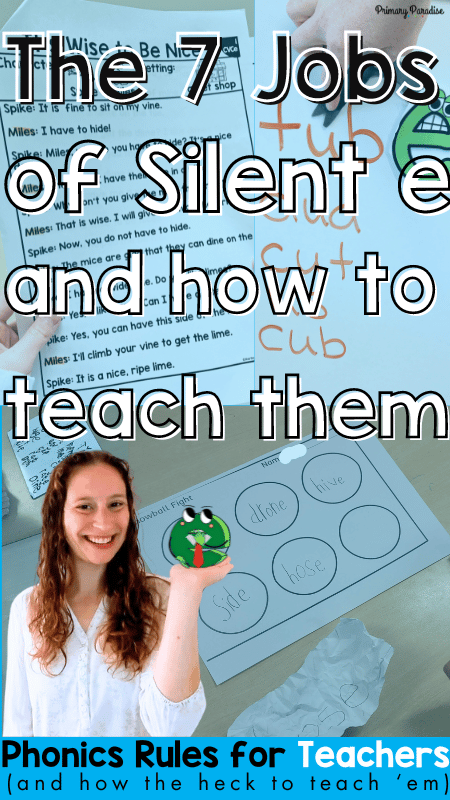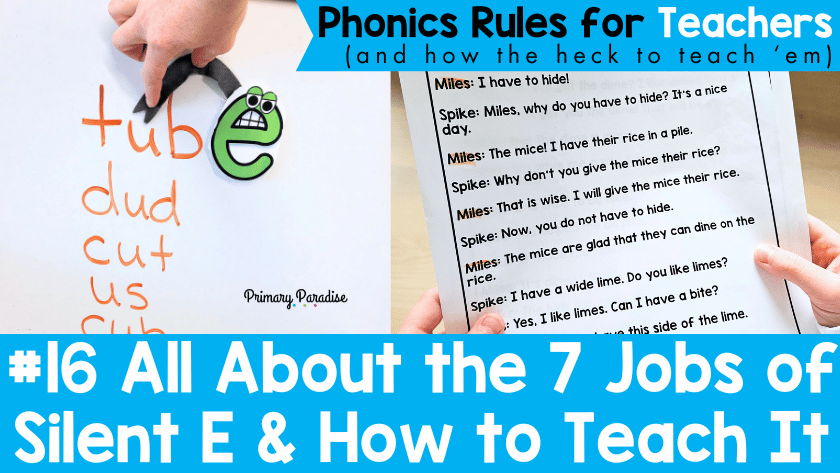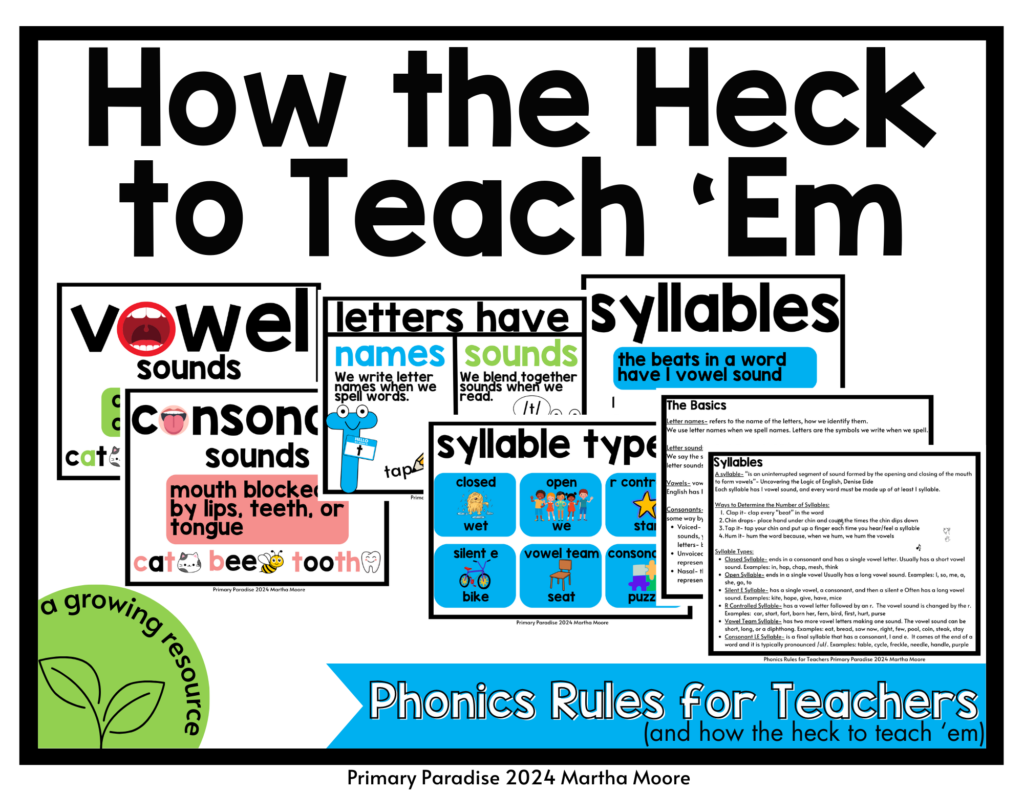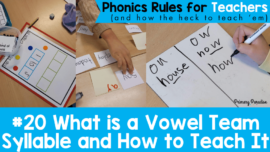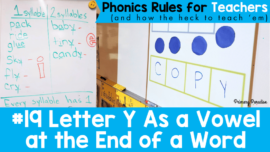Silent e does a lot more than making vowel sounds long. Silent e has 7 specific jobs in the English language. Here is everything you need to know about the silent e syllable and how to teach the jobs of silent e to your students.
This is post 16 in my series Phonics Rules for Teachers (and How the Heck to Teach ‘Em). If you’d like to see previous posts, you can click here.
Would you rather listen or watch? Find a podcast version of this blog post, or watch the video below.
What is a silent e?
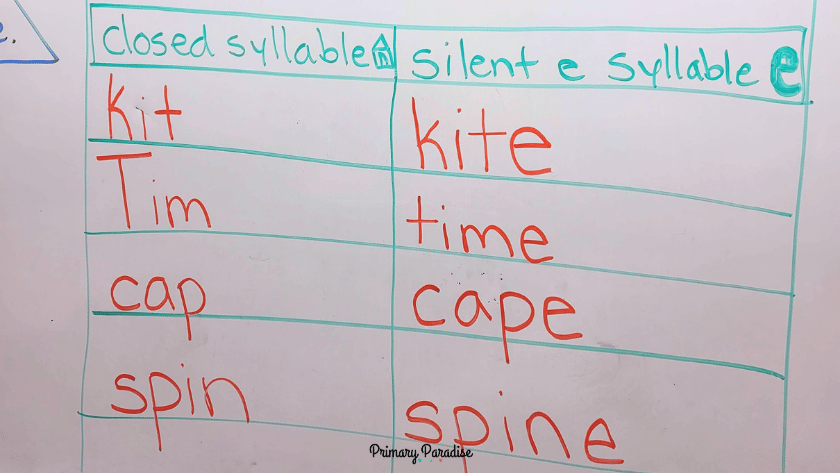
In many words in English, we see a vowel, a consonant, and then an e. This e at the end of a syllable is called a silent e because it’s not pronounced. Think of words like make, ride, and hope. Sometimes we see a silent e after two consonants as well such as breathe. Silent is a very common syllable type, and is typically the third type of syllable we teach students.
What are the 7 jobs of silent e?
You likely already know that silent e can make the vowel sound long in a word- for example can to cane. However, what about words like have or give? Silent e actually has 7 different jobs in English words. If we only teach our students the first job- to make the vowel long- they won’t get the full picture. Let’s take a look at the 7 jobs of silent e.
1. Silent e can make the vowel long
This is the most common and well know job of silent e. When we find a silent e in a word, it often causes the vowel to be long. Some examples are words like game, Pete, hide, note, and cute.
2. Silent e stops words from ending in v, i, u, and j
Words in English generally don’t end in the letters v, i, and u. We often add a silent e to words to prevent the word from ending in these letters. Some examples are have, pie, and glue.
3. Silent e makes c and g soft
Most of the time when we see a silent e next to c or g, those letters are representing the soft sound. For example, we see this in ice, race, cage, and stage.
4. Silent e makes th voiced
When we add a silent e to a word that ends in th, it then spells it’s voiced sound. An examples of this is breath vs breathe or bath vs bathe.
5. Silent e can make s hard
Sometimes when silent e is next to the letter s, it represents the /z/ sound such as wise or raise.
6. Silent e shows that a word is not plural
Typically an English word that ends in a single s is a plural word. For example cats, spoons, and trees. For this reason, sometimes we add a silent e after an single s of a singular word to stop any confusion. Some examples of this are house, goose, and purse.
7. Clarifies a word
We use silent E to clarify words. Sometimes, we add a silent E to a word that is a homophone to show that it is a different word with a different meaning. For example, “bye” and “by.”
How to Teach Silent e
Background Knowledge
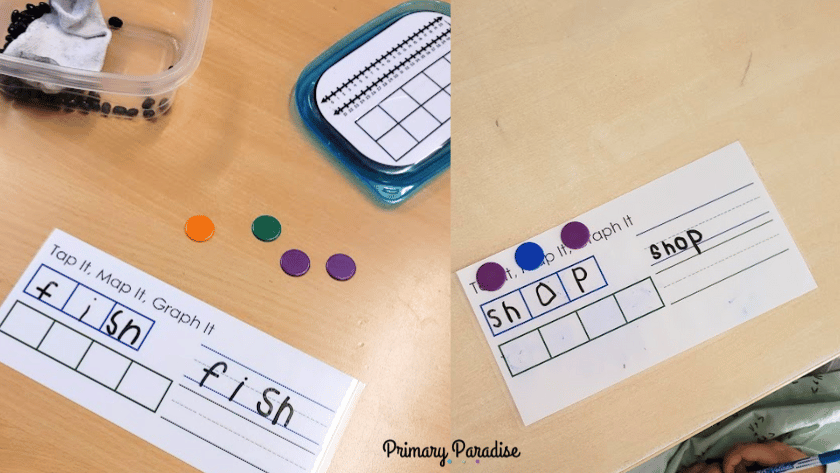
Before teaching the silent e syllable, make sure students have a firm background understanding of closed and open syllables. They should also understand short vowels and long vowels. Having this background knowledge makes it easier to teach silent e syllable words because you can build upon the knowledge they already know.
Start with the most common rule
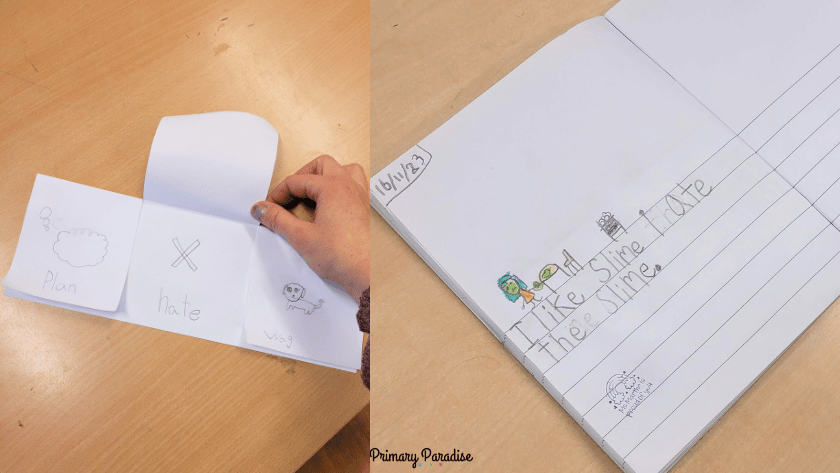
While silent e has 7 jobs, you don’t need to explain all 7 to your students right away. Instead, start with the most common job- making the vowel sound long. You can tell students that this is one job of silent e. Also, be sure to explain the pattern of this syllable type. Silent e syllables have a CVCE or a VCE pattern.
Compare with closed syllables
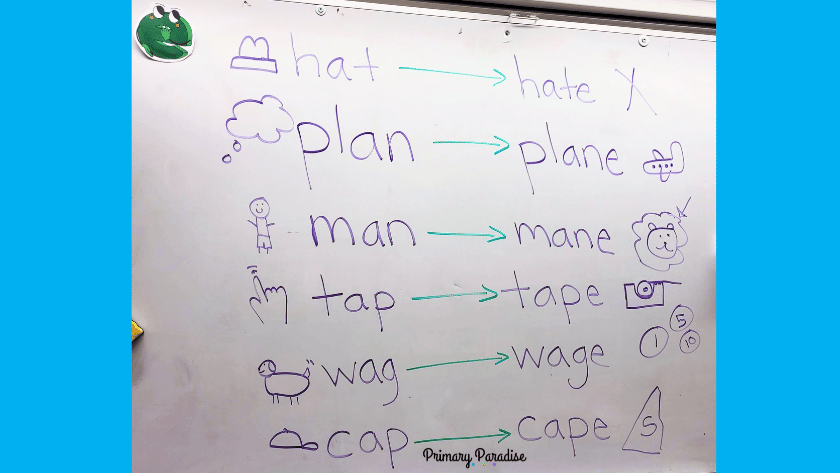
When you’re introducing silent e, you can start by writing closed syllable CVC or VC words that can be changed into a silent e word. Ask students to read the words- example can, kit, hop, and us. Then, rewrite the words with a silent e to the end of each word and explain how, in this syllable type, the vowel and e work together to spell a long vowel sound. So now read the new words together- cane, kite, hope, and use.
Comparing these two syllable types will help your students see the pattern of the silent e syllable very clearly while building off of the knowledge they already have.
Practice, practice, practice

Once you’ve introduced the silent e syllable, practice, practice, practice! You can use many of the strategies I’ve already shared for any new syllable type. Here are some brief explanations of my favorite activities (find my 12 favorite activities for ANY skill here).
- Daily sound drill– add silent e spelling patterns to your daily sound drill. I write them like this a_e, i_e
- Backwards decoding– show students the rhyme of a word, and then add the onset to help them focus on the spelling patterns. You can practice this with each silent e spelling pattern- a, e, i, o, and u- separately, and then also create a presentation together.
- Word mapping– have students map silent e words. There is also some debate as to where to put the silent e. I personally include it with the last consonant to avoid misspelling and confusion.
- Magic word game– the silent e syllable works well with this easy white board game because you can switch between closed, open, and silent e syllables- for example: no-not-note-rote-rot-dot-do-to-top-hop-hope
- Play games– It’s helpful to play different games with silent e words such as read find and cover or memory. The more students are having fun while working with CVCe words, the easier it will be to read and write them.
- Targeted journal entries– As you’re learning silent e words, you can make a list of words with your class and have them practice using them in context by writing a sentence in their journal.
- Read decodable texts– As always, continue to allow your students to practice reading new syllables and spelling patterns in context. I especially love having them use these decodable partner plays because they’re fun and collaborative.
Introduce soft and hard sounds
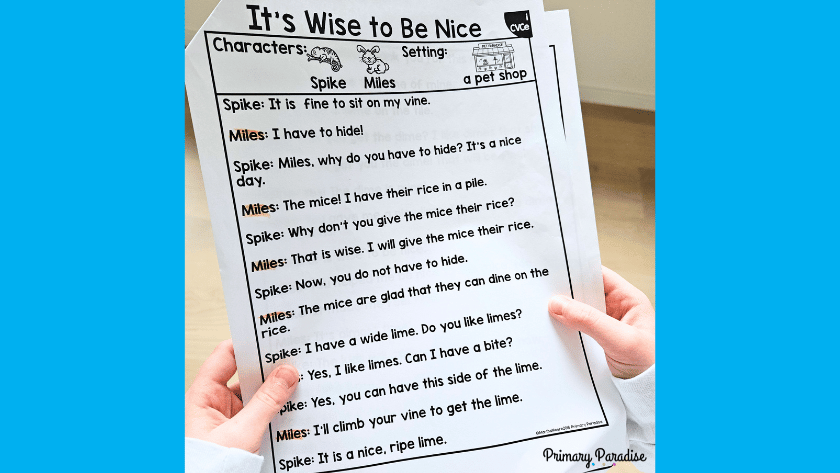
Once students understand the first job of silent e and have had time to practice, you can then teach them that certain letters next to silent e spell a different sound. You can show them words like ace, mice, cage, and stage. Explain that when i and g are followed by an e, they often spell the /s/ and /j/ sound. You can also teach them that, likewise, sometimes when s is proceeded by a silent e, it spells the /z/ sound. Again, you can practice this new skill with all of the activities I shared above. The key is to give students the new information and then allow them to get busy practicing and exploring right away.
Words in English don’t end with v, i, or u
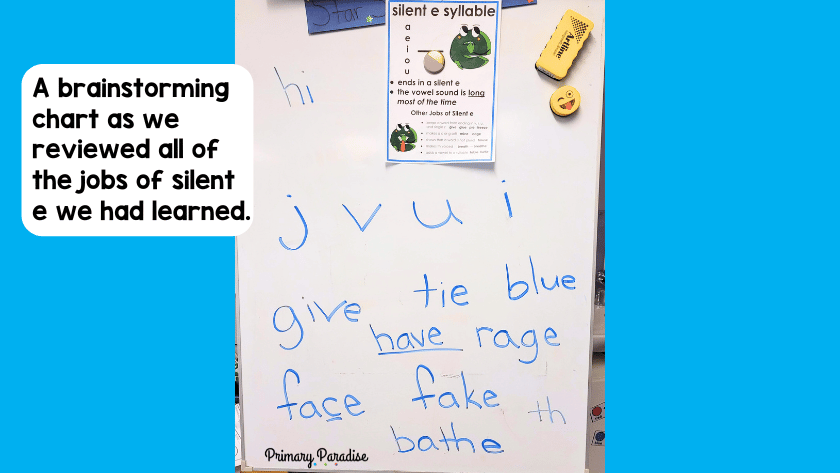
The next job of silent e is that words in English typically don’t end with v, i, or u. While there are some exceptions to this, most of the time those words are words English has borrowed from another language such as koi or ski. They are also sometimes abbreviations or slang words such as hi and flu. And finally, I always teach my students that I and you end with these letters because you and I are special.
Introduce this idea by writing the word have on the board and ask your students to read it. If they read it with a long a, ask them if that makes sense. If they read it correctly, then write the word give and repeat the process. Ask them what type of vowel sound they hear in these words (short). Explain that silent e has another job. Words in English don’t normally end with v, i or u. When a word would end with these letters, we often add a silent e to stop that from happening. You can share more examples such as glue, due and pie.
Singular rule
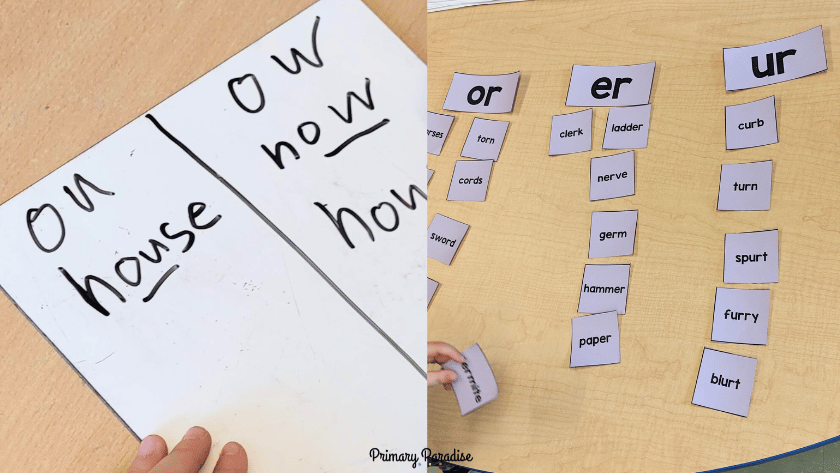
If your students are just learning silent e, wait to explain the singular rule until a bit later. For example, once you teach the vowel team ou and you look at words like mouse and house, or you learn ur and look at a word like purse, then you can explain why there’s an e at the end of the word.
Again, the goal is to teach English in a clear, logical way moving from less common, simpler spellings to more common and more complex. We don’t need to overwhelm our students with too much information too early.
Clarifies a word
Introduce introduce the 7th job of silent e when you’re talking about homophones or if words that are read the same but are spelled differently come up and they include words with this silent E on the end. For example, “by” and “bye.” You can explain to students that sometimes we add a silent E to words just so we can distinguish them from other words that sound the same but have a different meaning.
Continue to review
Finally, continue to review the silent e syllable type as you’re reading and writing together. All of these concepts build upon each other, so the more you go back and review, the better. Silent E is often part of multisyllabic words, so it’s really great for students to continue to practice this as the year goes on and as they grow as readers and writers. All of these concepts build upon each other, so the more you practice, the better for your students.
There you have it! Those are the seven jobs of silent E and how to teach them in your classroom. If you want resources to go along with all of the tools and strategies that I’m sharing here, you can find them in my How the Heck to Teach It resource, which is linked here in my website shop or here on TpT.
